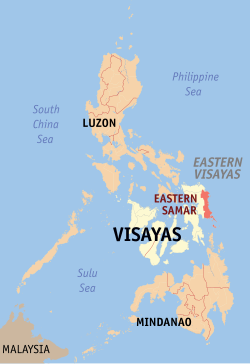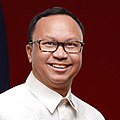| Eastern Samar's at-large congressional district | |
|---|---|
| Constituency for the House of Representatives of the Philippines | |
 Location of Eastern Samar within the Philippines | |
| Province | Eastern Samar |
| Region | Eastern Visayas |
| Population | 477,168 (2020) [1] |
| Electorate | 359,570 (2025) [2] |
| Area | 4,660.47 km2 (1,799.42 sq mi) |
| Current constituency | |
| Created | 1965 |
| Representative | Sheen Gonzales |
| Political party | Independent |
| Congressional bloc | Minority |
Eastern Samar's at-large congressional district is the sole congressional district of the Philippines in the province of Eastern Samar. Also known as Eastern Samar's lone district, it has been represented in the House of Representatives of the Philippines since 1965. [3] It first elected a representative provincewide at-large for the 6th Congress of the Third Philippine Republic following its creation and that of Northern Samar as regular provinces separate from Samar under Republic Act No. 4221 on June 19, 1965. [4] It has remained a single-member district for the House of Representatives as well as the Fourth Philippine Republic parliament known as the Regular Batasang Pambansa from 1984 to 1986. [3]
Contents
- Representation history
- Eastern Samar's at-large district for the House of Representatives of the Philippines
- Eastern Samar's at-large district for the Regular Batasang Pambansa
- Eastern Samar's at-large district for the House of Representatives of the Philippines 2
- Election results
- 2025
- 2022
- 2019
- 2016
- 2013
- 2010
- See also
- References
The district is currently represented in the 20th Congress by Sheen Gonzales, an independent. [5]




